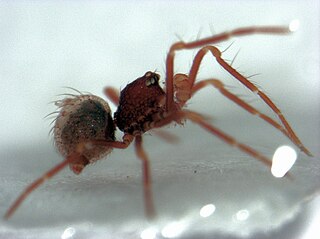Necatia is a genus of the jumping spider family Salticidae. Its only species, Necatia magnidens, is found in southern China.

Periegops is a genus of spiders with six eyes instead of the usual eight. It is the only genus in its family (Periegopidae) and has three described species. It was long considered to be members of Sicariidae or Segestriidae until Raymond Forster elevated them to the family level in 1995.

The Micropholcommatinae are a subfamily of araneomorph spiders in the family Anapidae. They were previously treated as the family Micropholcommatidae. Micropholcommatins are extremely small, with body lengths typically between 0.5 and 2 mm. They are usually found among leaf litter or moss.

Styposis is a genus of comb-footed spiders that was first described by Eugène Louis Simon in 1894. It is a senior synonym of Cyatholipulus.

Thwaitesia is a genus of comb-footed spiders that was first described by Octavius Pickard-Cambridge in 1881.
Uapou is a monotypic genus of South Pacific sheet weaver spiders containing the single species, Uapou maculata. It was first described by Lucien Berland in 1935, and is found on Ua Pou, one of the Marquesas Islands. It was transferred to the family Symphytognathidae by H. W. Levi in 1972, but this was rejected by Brignoli in 1980. The World Spider Catalog places it in the family Linyphiidae.
Andasta is a genus of ray spiders that was first described by Eugène Louis Simon in 1895.
Oedignatha is a genus of Asian spiders first described by Tamerlan Thorell in 1881 as a genus of corrinid sac spiders, and moved to Liocranidae in 2014.
Propostira is a genus of Asian comb-footed spiders that was first described by Eugène Louis Simon in 1894. As of June 2020 it contains two species, found in Sri Lanka and India: P. quadrangulata and P. ranii.
Olbus is a genus of South American corinnid sac spiders first described by Eugène Simon in 1880 as a huntsman spider. It was moved to the sac spider family in 1988, then to the Corinnidae in 2001.
Cyatholipus is a genus of African araneomorph spiders in the family Cyatholipidae, and was first described by Eugène Simon in 1894. Originally placed with the ray spiders, it was moved to the Cyatholipidae in 1978.
Synaphris is a genus of araneomorph spiders in the family Synaphridae, and was first described by Eugène Louis Simon in 1894. Originally placed with the tangle web spiders, it was moved to the Symphytognathidae in 1973, and to the Synaphridae in 2003.
Entypesa is a genus of African mygalomorph spiders in the family Entypesidae. It was first described by Eugène Louis Simon in 1902. Originally placed with the curtain-web spiders, it was transferred to the funnel-web trapdoor spiders in 1985, then to the Entypesidae in 2020. It is a senior synonym of Pseudohermacha.

Allocyclosa is a genus of orb weaver spiders that contains only one species, Allocyclosa bifurca. It was first described in 1887 by McCook under the name Cyrtophora bifurca, and was transferred to its own genus in 1999. It is the only Cyclosa species north of Mexico to have a forked tail, hence the name bifurca, Latin for "two-forked". The forked abdomen, bearing two humps shaped like the letter M, is a defining feature in both males and females, though it is similar to features present in certain Cyrtophora species. Both sexes are a transparent green color, though only females have an area of red on their underside between the epigynum and the spinnerets. Females are nearly thirty percent larger than males, ranging from five to nine millimeters, while males range from two to three millimeters. Males are very uncommon. In a 1977 study by Levi, only two of the nearly 350 specimens that were positively identified as Cyrtophora bifurca were males. This is a very odd distribution, and it has been posed that females of the species, which have less prominent genitalia relative to other members of the orb-weaver family, may be parthenogenic, or able to reproduce without the help of males. Like other members of Araneidae, these spiders create orb webs, six to eight inches in diameter, but apply a unique form of protective mimicry. Females sit in the middle of a vertical row of web decoration, with egg sacs above and wrapped prey below. Because they all have a similar color and shape, it is difficult to discern between the egg sacs, the wrapped prey, and the spider itself.
Sedasta is a genus of African orb-weaver spiders containing the single species, Sedasta ferox. It was first described by Eugène Simon in 1894, and has only been found in West Africa. It was originally placed with the tangle-web spiders, and though was moved to the orb-weavers in 1985, it is still sometimes considered to be a theridiid or a long-jawed orb weaver.
Mecynidis is a genus of African dwarf spiders that was first described by Eugène Louis Simon in 1894. Originally placed with the tangle-web spiders, it was moved to the Linyphiidae in 1964.
Pholcomma is a genus of comb-footed spiders that was first described by Tamerlan Thorell in 1869.
Tomoxena is a genus of Asian comb-footed spiders that was first described by Eugène Louis Simon in 1895. As of June 2020 it contains three species, found in Asia: T. alearia, T. dives, and T. flavomaculata.
Theonoe is a genus of comb-footed spiders that was first described by Eugène Louis Simon in 1881.




